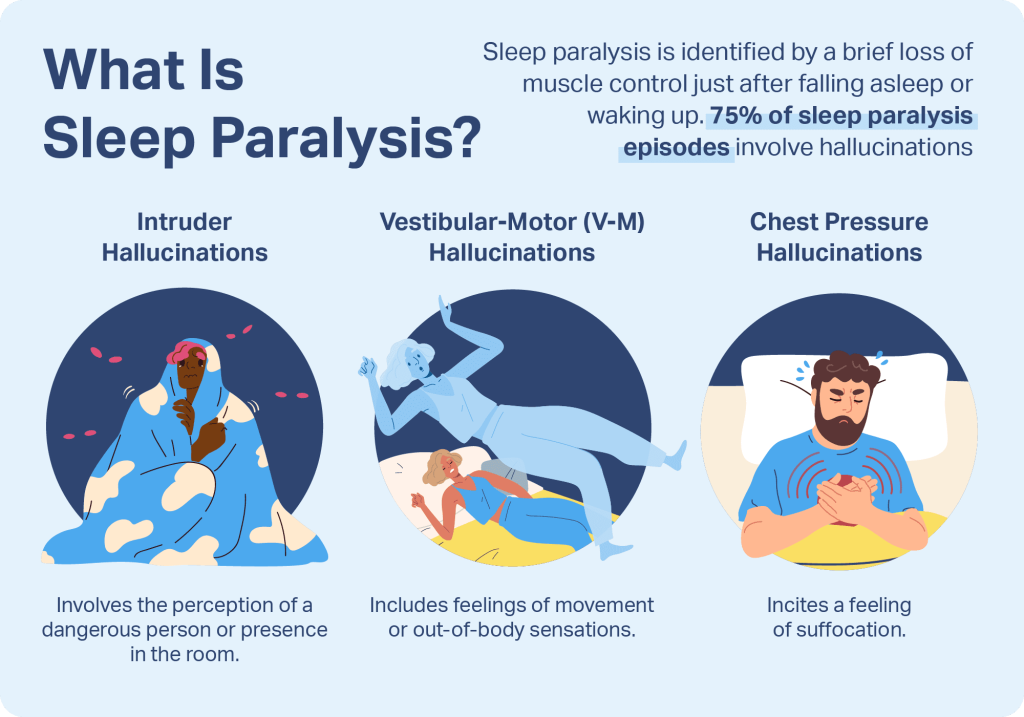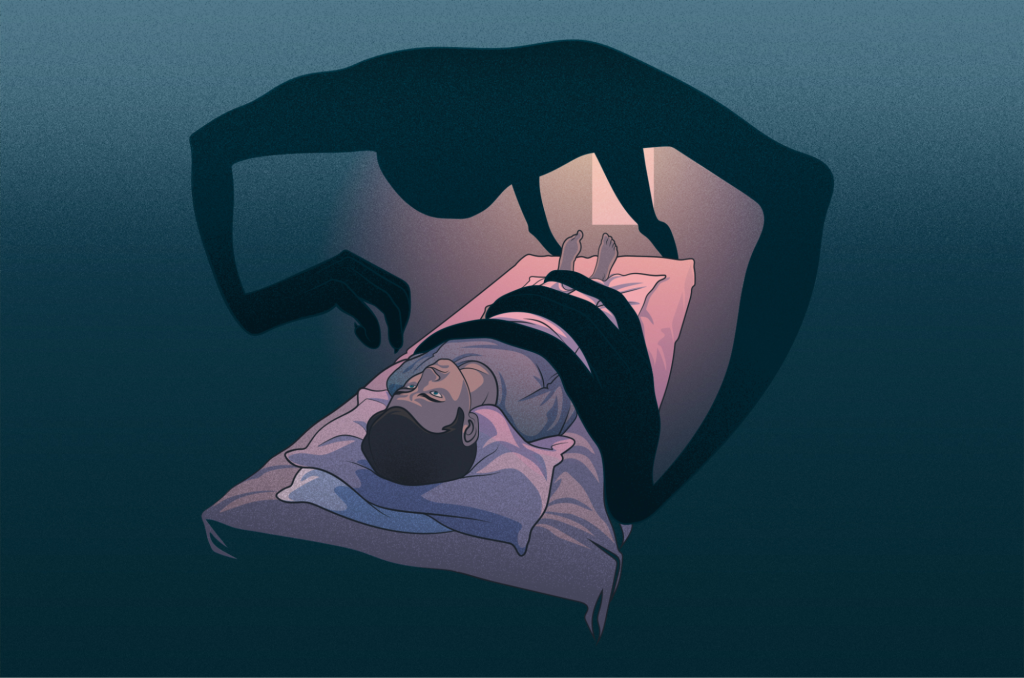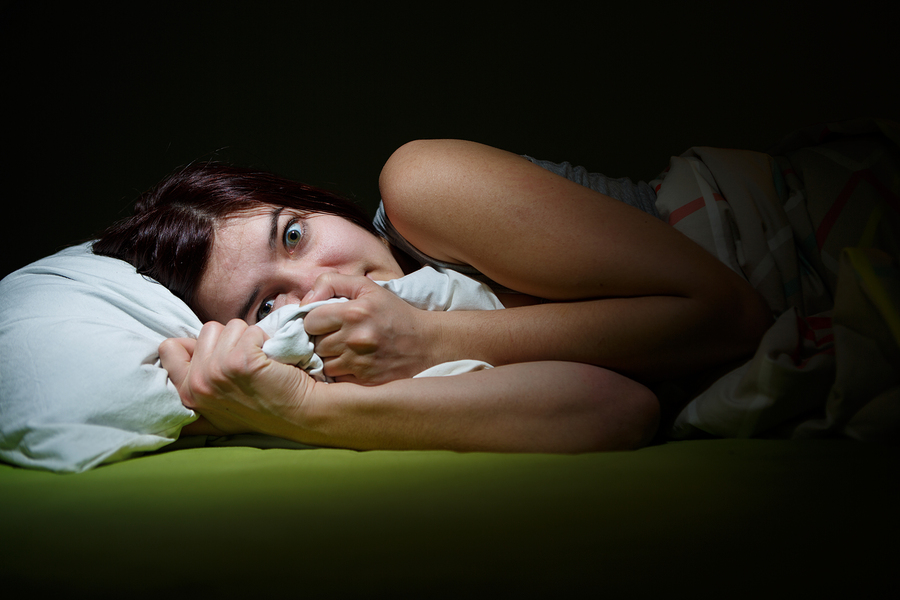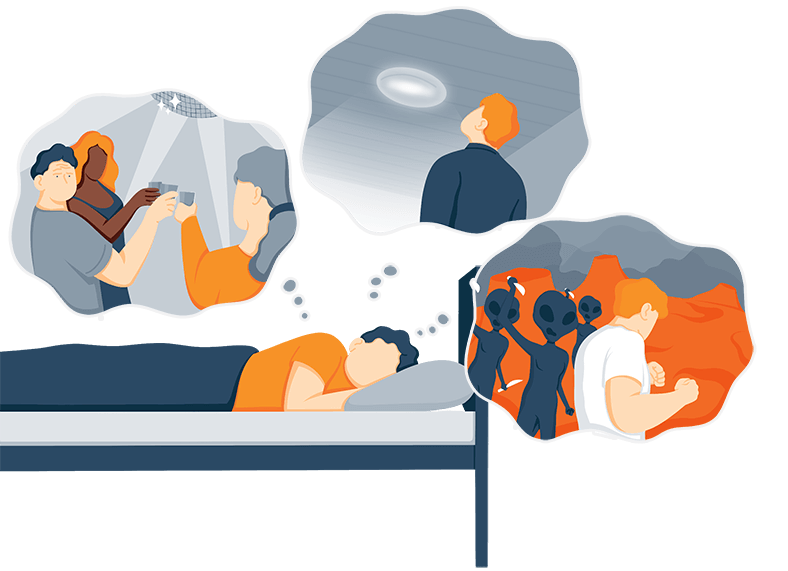Sleep Paralysis: in Detail
It sounds like a nightmare: you are completely immobilized when you are fully aware of your own body. However, for many people suffering from sleep paralysis, this is a reality. What sleep paralysis actually is?
Behind the phenomenon of sleep paralysis lies a protective mechanism of the human body, which can be very frightening and stressful for those affected.
People who suffer from different types of sleep paralysis usually wake up in the middle of the night and can no longer move their limbs. In the state of a paralysis, which feels like being trapped in one's own body, figures such as demons or witches are also often perceived.
What at first seems threatening, however, is completely harmless and treatable. Read all the important information about this disorder here and get an overview of its causes, risk factors, and symptoms. In addition, we will offer you some preventive measures you can take yourself. Is sleep paralysis dangerous? Are sleep paralysis and sleep apnea connected? How to wake up during sleep paralysis? Let's try to find answers to these questions.
What is it?
Sleep paralysis is a largely unexplored phenomenon. In medicine, this paralysis is subordinated to sleep disorders, so-called parasomnias.

It is, therefore, not a disease in the classic sense, and there is no universal drug against it. During the night, humans go through four different phases:
-
Light phase.
-
Deep phase.
-
REM phase (rapid eye movement).
During these phases, breathing, heartbeat, and brain activity slow down. This disturbance occurs particularly in the REM phase.
It is a state between wakefulness and sleep. People affected feel paralyzed and tied to the mattress: they cannot speak and are unable to move.
Only their eye movements and breathing retain full functionality. The entire body is frozen, but the senses are wide awake. For this reason, the entire musculature freezes, except for vital functions such as heart and respiratory rates. In this state, the human psyche incorporates dream elements into real events. Is it sleep paralysis or a dream? It is paralysis, but a person does not understand it and feels really terrified seeing demons, ghosts, etc.
These dream elements woven into the waking state can lead to a kind of hallucination or misperception. In a hallucination, sensory impressions are perceived for which there are no external stimuli.
Voices can be heard, or a person can even see "shadow people" and other beings that are not real. Those who do not have visual hallucinations, however, feel the presence of mythical creatures in the room.
Some people also have a feeling of being touched or something pressing on their chest, making it difficult to breathe. Doctors call this tactile hallucinations. Is sleep paralysis without hallucinations possible? It is, but most cases are accompanied by hallucinations of different types.

A special form of paralysis is when people have an out-of-body experience. They observe themselves, so to speak, from the ceiling or a corner of the room. All of these forms of paralysis trigger a feeling of helplessness and represent a true horror experience for most of those affected.
Normally, this paralysis disappears on its own at the latest after waking up. Either the muscle strength returns after a few minutes, or a person affected falls asleep again, and the paralysis is over. Some say it may be difficult to wake up from sleep paralysis.
Short-lasting signs of paralysis (muscle atony) in waking seizures are the body's protective reaction: they prevent dreamed movements from actually being translated into reality.
In other words, the musculature is paralyzed so that the movements of the dream are not actually carried out, as this could be dangerous. Normally, however, this state is not experienced consciously.
Causes and triggering factors
Science does not yet have precise answers to how it occurs, the exact causes, and why hallucinations sleep paralysis appear. Children and adults of all ages can suffer from it. However, there is a higher risk of parasomnia in certain people.
In some cases, the problem appears to occur frequently within families. However, there is no scientific evidence that the disease is hereditary so far. Researchers believe that several factors can trigger it (as well as different types of sleep paralysis hallucinations).
Sleep disorders and problems
The phenomenon often occurs in connection with narcolepsy. This is a neurological disease with sudden sleep attacks during the day. It is a disturbance of the sleep-wake rhythm in which certain messenger substances (transmitters) in the brain get confused due to a genetic predisposition. In people with narcolepsy, the clear separation between the REM phase and the waking state is disturbed.
There also seems to be a stronger correlation between paralysis and obstructive sleep apnea (OSA). At the OSA, breathing interruptions repeatedly occur while sleeping. It was found that 38% of people with OSA have also experienced paralysis at least once.
Insomnia, disorders, and excessive daytime sleepiness can also be associated with multiple paralysis cases. Likewise, a disturbed sleep-wake rhythm, such as jet lag or shift work, seems to promote a higher risk of nightmare and sleep paralysis.
Mental illnesses
There also seems to be a connection between mental illnesses and sleep apnea sleep paralysis. People who suffer from certain mental disorders, such as anxiety disorders or panic disorders, seem to be afflicted by it more often.
People with post-traumatic stress disorder (PTSD) and other forms of physical and emotional stress also experience sleep paralysis insomnia more often than average.
Other causes and triggers of sleep paralysis at a glance
What do you see in sleep paralysis? You can see different things, but they are mainly frightening. To understand the picture fully, let's summarize all the main causes. Here are several possible reasons for good sleep paralysis.
-
Family predisposition.
-
Insomnia, lack of sleep.
-
Narcolepsy.
-
Anxiety disorders.
-
Severe depression.
-
Bipolar disorders.
-
Post-traumatic stress disorder (PTSD).
-
Mental stress: grief, separation, professional tension.
-
Stress.
-
Poor sleep hygiene.
-
Disorders.
-
Night shifts.
-
Jet lag.
-
Alcohol and drug abuse.
-
Back sleeping.
-
Daydreaming.
Symptoms and side effects
We have already briefly discussed what you see during sleep paralysis. Let's take a more detailed look at the phenomenon. So, the paralyzing state can last a few seconds to 20 minutes. The average length is between six and seven minutes. The longer it lasts, the more disturbing and shocking the experience is for those affected. People cannot speak or draw attention to the situation.
As was mentioned, in most cases, the episodes end by themselves but can also occasionally be interrupted by the touch or voice of another person or by your own intense effort to move.
Hallucinations
Sleep paralysis causes hallucinations; you already know it. The visual and acoustic illusions of the senses are sometimes real horror scenarios that deal with the life and death of the sleeper. Topics such as torture, degradation, dying or murder, and eerie, dark figures, monsters, or mythical creatures are vividly perceived.
The body gets into fear and panic, adrenaline shoots through the blood vessels, and attempts follow to get the body back under control. All of a sudden, the haunting is over again, and the body can move as if nothing had happened. What remains, however, is an extremely bland aftertaste.

Hallucinations can manifest themselves in many ways. Typical perceptions include:
-
Sounds: voices, screams, steps, humming, or noise are heard.
-
Presence of strangers: persons not present are perceived, which is really terrifying.
-
Other sensory perceptions: feelings of cold, heat, or pressure on the body (chest basket) that cause a feeling of suffocation.
-
Out-of-body experiences or astral journeys: in a dream, those affected experience themselves outside their own body, look at each other, and move away regardless of time and space.
-
Demons and ghosts: dark, black figures, shadows, or animals haunt those affected in dreams and want to make contact with the paralyzed with malicious intent.
Science is still in the dark as to why exactly such terrible scenarios afflict us at night. Even if the deliberate unpleasant paralysis is harmless, it looks like a nightmare. If the phenomenon is experienced, it can terrify affected persons a lot. The experienced fear of death, the fear of permanent paralysis, or mental illness can have an effect over a long time.
Interesting facts
Here are some facts about the phenomenon you may find interesting.
-
It affects women and men equally.
-
The phenomenon mainly occurs between the ages of 25 and 44.
-
It can last from a few minutes to an entire hour in some cases.
-
Researchers have found that sleeping on your back significantly increases your chances of developing the problem.
-
Irregular sleeping or deprivation also promotes paralysis.
-
Islamic scholars consider it a punishment from a jinn (evil spirit).
-
Some people try to trigger this phenomenon at will and go on an "astral journey."
-
This topic was often taken up in art. The most prominent of these is the painting "The Nightmare" by Johann Heinrich Füssli (1741–1825).
Prevention measures
In this context, education and advice have proved their worth. It should be noted here that paralysis is not life-threatening, which is a great relief for many people.

If you are afraid of it when you go to bed, this can even promote it.
So it is important to eliminate the fear of falling asleep, build enough relaxation into your everyday life, and solve existing conflicts.
You can seek therapeutic support for this. In severe cases, medications, such as antidepressants, can help. However, these can also have side effects and should, therefore, only be taken in extreme emergencies.
The doctor may also provide tips and mechanisms for resolving the state of paralysis. Healthy sleep hygiene is of central importance for the prevention of sleep paralysis. Here are some tips:
-
Deal with stress.
-
Maintain constant sleeping and waking times (biorhythm).
-
Don't sleep on your back.
-
Getting enough sleep (ideally seven to eight hours a night).
-
No bright lights by the bed or in the room.
-
Avoid "naps" during the day.
-
Don’t oversleep.
-
Do not burden your body with hard-to-digest meals three hours before bedtime.
-
Do not drink alcohol three hours before bed.
-
Stop caffeine about four hours before bed.
-
Get some rest before bed. Do without smartphones and PCs.
-
Purchase high-quality bedding. Perhaps you simply need a new mattress.
Diagnosis
If you have experienced a worrying episode with hallucinations for the first time, you would definitely like to have the symptoms clarified. The first point of contact is then a family doctor's office.
As a rule, no medical tests are required to diagnose the problem. As part of a detailed initial consultation (anamnesis), your doctor will ask you many questions about sleep behavior and general medical history to rule out possible causes such as narcolepsy or sleep apnea.
Sometimes keeping a sleep diary is also helpful to accurately document the episodes and experiences.
A night in the sleep laboratory is also recommended if sleep quality is severely impaired due to sleep paralysis and the suffering pressure is very high. There, the brain waves and breathing can be checked while sleeping.
The severity of the disorder can then be determined using polysomnography, electromyography (EMG), electroencephalography (EEG), and a multiple sleep latency test (MSLT).
-
Polysomnography: sleep, breathing, circulation, and movement are measured and recorded throughout the night.
-
Electromyography: the sagging of our muscles is checked using it.
-
Electroencephalography: the electrical activity of our brain is measured and graphically displayed.
-
Multiple sleep latency test: it is done to check whether it is an isolated (non-hazardous) disorder or whether it is a symptom of narcolepsy.
Therapy
How to stay asleep all night without suffering from paralysis? The good news is that paralysis is usually not a serious problem and is classified as benign because it usually does not appear often enough to cause significant health problems.
However, it is estimated that about 10% of those affected suffer from frequently recurring episodes, which make it very stressful. In this way, negative thoughts about bedtime can develop, which shorten bedtime or cause fears of bedtime, making falling asleep difficult.
Permanent deprivation or lack of sleep can lead to excessive drowsiness and have many other negative consequences for general health. So how can this problem be treated?

Overall, there is limited scientific knowledge about the optimal treatment of sleep paralysis. If the episodes of sleep paralysis, the frequency, and the severity of the paralysis experienced are related to narcolepsy or sleep apnea, the therapy is aimed at the possible causes or the underlying problem.
A very important element for the treatment of sleep paralysis is education and advice on the phenomenon. This also includes the patient's sleep hygiene. In addition, in some cases, patients also have drug treatment or psychotherapy for mental disorders as a possible cause.
Calming information about the phenomenon
The physician usually begins treatment by informing those affected about the problem and its essence. He explains the different phases of sleep and says that paralysis all over the body is a natural process and is part of the normal sleep process during the REM phase and that it is basically classified by doctors as a harmless phenomenon.
Understanding that paralysis and hallucinations stop on their own is also very helpful. After that, those affected often feel relief and can better understand and classify both paralysis and hallucinations when the problem occurs repeatedly.
The detailed consultation has a calming effect and, therefore, also relieves those affected by a large portion of fear and stress.
Train willpower and techniques
In some cases, those affected manage to free themselves from the problem that occurs by training their will and developing certain techniques so that they can actively end the condition.
The smallest movements can end paralysis. To be able to move a finger or toes, strong concentration is required. Sometimes those affected can also make a small sound or draw the bed partner's attention to the situation by breathing loudly. If the partner reacts to the condition with touch or loud noises, the condition can be stopped.
Drug therapy
If the stress from paralysis and/or hallucinations is very pronounced, drug treatment could also be used.

Drugs are only prescribed by a doctor in very severe cases. Therefore, the intake, as well as the advantages and disadvantages, should only be discussed during a consultation with the doctor.
There are drugs that can suppress REM sleep and thus prevent sleep paralysis. The medications should only be taken in exceptional cases because the medicines are accompanied by side effects.
If sleep paralysis is based on narcolepsy, selective serotonin reuptake inhibitors (SSRIs) such as Prozac are usually prescribed. This type of stimulant is intended to ensure that those affected stay awake.
In particularly severe cases, antidepressants are sometimes prescribed. The intake is intended to reduce the frequency of dreams, which in turn should reduce the occurrence of sleep paralysis. Tricyclic antidepressants such as imipramine and clomipramine are most commonly used. Using any of those without consultation can lead to a disaster, so never choose medications yourself.
Psychotherapy
If a mental disorder is a trigger, psychotherapeutic support for insomnia in the form of cognitive behavioral therapy is usually recommended. Psychotherapy should go hand in hand with good sleep hygiene in order to be able to ensure restful sleep again.
The aim of behavioral therapy is to rearrange and shape negative thoughts and emotions that contribute to irregular sleep rhythm and affect it. A special form of this therapy has been developed for sleep paralysis, but there is not yet sufficient scientific evidence of its effectiveness.
However, behavioral therapy is successfully used for anxiety or post-traumatic stress disorder. Both disorders are among the factors that can influence sleep paralysis. The effectiveness of psychotherapy has been proven in both cases.
Conclusion
As you can see, the problem can be diagnosed and cured. If you suffer from it and are terrified by what you see in sleep paralysis, don't be afraid to consult a doctor who will provide all the help you need.